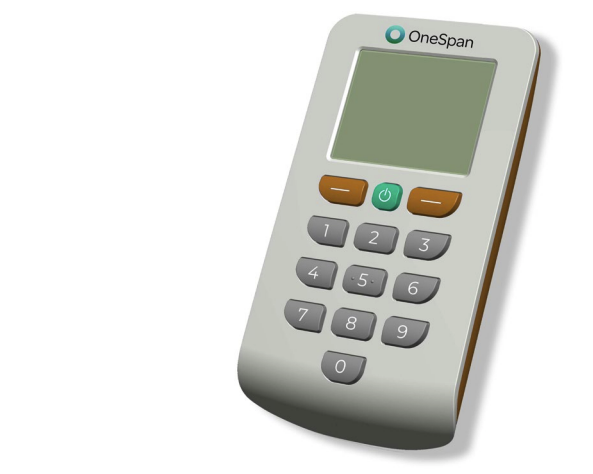HIGHLIGHTS
Exceptionally convenient
- No manual data entry. No confusion. Users simply scan a Cronto image with the built-in camera of Digipass 772, instantly displaying the full transaction on-screen. What you see is what you sign, literally.
Mitigate fraud
- Combat sophisticated threats and deliver the most optimal combination of usability, security, and cost of ownership by allowing users to verify and sign transactions anytime, anywhere.
Digipass 772 with patented Cronto® technology provides a secure and user-friendly solution for banks looking to protect online transactions from today’s most sophisticated cyber threats. Its compact form factor, visual transaction signing, and ease of deployment make it the ideal fit for organizations that require robust security without sacrificing usability.
Uncompromising security
Digipass 772 delivers robust protection against the most sophisticated fraud techniques threatening today’s digital banking systems, including phishing, social engineering, and banking Trojans. It is specifically engineered to defend against adversary-in-the-middle (AitM) and man-in-the-browser (MitB) attacks, two of the most insidious methods used to alter transaction data undetected.
By generating a unique electronic signature for each transaction, based on critical details such as account numbers, amounts, or any bank-defined text, Digipass 772 ensures data integrity and authenticity. Once a transaction has been signed, any tampering renders it invalid, giving both banks and users complete confidence that what was authorized is exactly what will be executed.
What you see is what you sign
At the heart of Digipass 772 is the patented Cronto visual transaction signing technology, which encrypts transaction information and displays it securely on the device’s large color screen.
This visual representation ensures the user is always in control, able to review and verify the full transaction details before confirming.
Unlike traditional methods that require trust in potentially vulnerable channels, this approach gives the user complete visibility into what they are signing. It’s a user-centric method that blends strong security with clarity and transparency, offering protection against adversary-in-the-browser and adversary-in-the-middle attacks.
Fast, flexible deployment
Digipass 772 is designed for easy, largescale deployment. As a non-personalized device, it does not need to be manually assigned to individual users. Instead, activation is done via a secure code delivered through email or physical letter. Once received, the user simply registers the device by scanning a Cronto activation image—no IT intervention or in-person setup required.
For institutions that prefer a more customized approach, pre-personalization is also available. This deployment flexibility supports a variety of rollout strategies, from centralized issuance to self-service enrollment, without introducing operating complexity.
How it works
Digipass 772 streamlines secure transaction signing through a simple, intuitive process:
• The user initiates a transaction on the bank’s website.
• Transaction details are encrypted and presented as a Cronto image on the user’s computer, mobile phone, or tablet.
• The user scans the Cronto image with the Digipass 772’s built-in camera.
• After entering a personal PIN on the keypad, Digipass 772 decrypts and displays the transaction on its screen.
• The user reviews the details and if everything is correct, confirms the transaction.
• Digipass 772 generates a unique signature code, which the user enters into the bank’s website to confirm the transaction.
This process ensures that only the intended transaction is approved, and no hidden modifications are accepted.
Transaction security without compromise
Digipass 772 combines robust cryptographic security with an intuitive user experience, offering a future-ready solution for securing digital banking transactions. Its simple deployment model, strong compliance alignment, and user-centric design make it an ideal choice for financial institutions seeking to enhance trust, reduce fraud, and meet today’s rigorous cybersecurity standards. With Digipass 772, banks can confidently secure their digital channels without compromising convenience.

TECHNICAL SPECIFICATIONS
Size
10,12 cm (L) x 5,5 cm (W) x 1,82 cm (H)
Weight
78g (41g without batteries)
Display
1,77 in. TFT color display (128 x 160 dots)
Camera
Camera with live video streaming (640x480)
Languages
Multilingual support
Battery
3 replaceable AAA-batteries*
*The device must not be used with USB rechargeable batteries
CERTIFICATION AND COMPLIANCE
Short-term Storage Temperature
-10°C to 50°C
90% RH non-condensing
IEC60068-2-78 (damp heat)
IEC60068-2-1 (cold)
Operating Temperature
0°C to 45°C
85% RH non-condensing
IEC60068-2-78 (damp heat)
IEC60068-2-1 (cold)
Vibration
10 to 75 Hz
10 m/s2
IEC60068-2-6
Drop
1 meter
IEC60068-2-31
Emission
EN55032
Immunity
4 kV contact discharges
8 kV air discharges
3 V/m from 80 to 1000 MHz
EN55024
Compliant with European directives
CE: 89/336/EEC or 2004/108/EC
RoHS: 2002/95/EC
WEEE: 2002/96/EC
* Batteries should be stored at temperatures between 50°F (10°C) and 77°F (25°C), with relative humidity not exceeding 65 percent. Refrigeration of alkaline batteries is not necessary because of their very good capacity retention. Excessive temperature cycling and storage at temperatures greater than 77°F (25°C) should be avoided to maximize shelf life.






